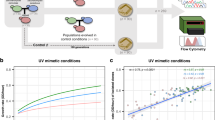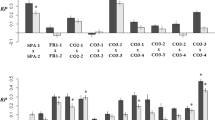Summary
This paper uses algebraic analysis and computer simulation to examine the contribution of homozygote disadvantage created by mutational load to selection for translocation heterozygosity in selfing populations. It is shown first that in structurally homozygous populations mutation pressure can lead to the accumulation of deleterious mutations, as opposed to the establishment of a stable equilibrium between mutational input and selective elimination. The speed of accumulation depends on the mutation rate and inversely on the selection coefficients against deleterious alleles, the population size and the amount of recombination. It is also shown that translocations can be selected, given a sufficiently high rate of mutation per chromosome and provided that crossing-over is suppressed in structural heterozygotes. Incomplete dominance of deleterious mutations lowers the strength of selection for translocations, compared with the case of complete recessivity. In all cases when translocations are selected there is accumulation of deleterious genes in structural heterozygotes, so that the final population consists entirely of structural heterozygotes, the homozygotes behaving effectively as recessive lethals.
The model is discussed in relation to what is known about translocation heterozygosity in natural populations, and about mutation rates and selection coefficients for deleterious genes. It is concluded that an unrealistically high mutation rate is probably needed for this mechanism to be the sole factor involved in initiating the evolution of complex heterozygosity in largely self-fertilising plants. It may, however, be an important contributary factor, and we show that it is likely to be more important, the larger the number of interchanges already established in the population.
Similar content being viewed by others
Article PDF
References
Bhaduri, A. 1942. Further cytological investigations in the genus Gaura. Ann Bot, 6, 229–244.
Charlesworth, B. 1979. Selection for gamete lethals and S-alleles in complex heterozygotes. Heredity, 43, 154–164.
Charlesworth, B, and Charlesworth, B. 1973. Selection of new inversions in multi-locus genetic systems. Genet Res, 21, 167–183.
Charlesworth, D, and Charlesworth, B. 1979. Selection on recombination in partially self-fertilising populations. Submitted to Genetics.
Charlesworth, D, Charlesworth, B, and Strobeck, C. 1977. Effects of selfing on selection for recombination. Genetics, 86, 213–226.
Cleland, R E. 1972. Oenothera Cytogenetics and Evolution. Academic Press, London and New York.
Darlington, C D. 1958. Evolution of Genetic Systems. Oliver and Boyd, Edinburgh.
Dobzhansky, T. 1931. The decrease of crossing over observed in translocations and its probable explanation. Amer Nat, 65, 214–232.
Feldman, M W. 1972. Selection for linkage modification. 1. Random mating populations. Theor Pop Biol, 3, 324–346.
Feldman, M W, and Balkau, B. 1972. Some results in the theory of three gene loci. In Population Dynamics, ed. T. R. E. Greville. Academic Press, New York.
Felsenstein, J. 1974. The evolutionary advantage of recombination. Genetics, 78, 737–756.
Haigh, J. 1978. The accumulation of deleterious genes in a finite population—Muller's ratchet. Theor Pop Biol, 14, 251–267.
Haldane, J B S. 1937. The effect of variation on fitness. Amer Nat, 71, 337–349.
Haldane, J B S. 1950. The association of characters as a result of inbreeding and linkage. Ann Eugen, 15, 15–23.
Heller, R, and Maynard Smith, J. 1979. Muller's ratchet with selling. Genet Res, 32, 289–293.
Hoar, C S. 1931. Meiosis in Hypericum punctatum. Bat Gaz, 92, 396–406.
Holden, L R. 1979. New properties of the two-locus partial selfing model with selection. Genetics, in press.
James, S H. 1965. Complex hybridity in Isotoma petraea. I. The occurrence of interchange heterozygosity, autogamy and a balanced lethal system. Heredity, 20, 341–353.
James, S H. 1970. Complex hybridity in Isotoma petraea. II. Components and operation of a possible evolutionary mechanism. Heredity, 25, 53–77.
John, B, and Lewis, K R. 1958. Studies on Periplaneta americana. III. Selection for heterozygosity. Heredity, 12, 185–197.
John, B, and Lewis, K R. 1959. Selection for interchange heterozygosity in an inbred culture of Blaberus dixoidalis (Serville). Genetics, 44, 251–267.
Lewis, H, and Szweykowski, J. 1964. The genus Gayophytum. Brittonia, 16, 343.
Lewis, K R, and John, B. 1957. Studies on Periplaneta americana. II. Interchange heterozygosity in isolated populations. Heredity, 11, 11–22.
Lewis, K R, and John, B. 1963. Chromosome Marker. Churchill, London.
Maynard Smith, J, and Haigh, J. 1974. The hitch-hiking effect of a favourable gene. Genet Res, 23, 23–55.
Mooring, J. 1958. A cytogenetic study of Clarkia unguiculata. Amer J Bat, 47, 233–242.
Muller, H J. 1964. The relation of recombination to mutational advance. Mut Res, 1, 2–9.
Nei, M, Kojima, K, and Schaefer, H. 1967. Frequency changes of new inversions under mutation-selection equilibria. Genetics, 57, 741–750.
Rana, R S, and Jain, H K. 1965. Adaptive role of interchange heterozygosity in the annual Chrysanthemum. Heredity, 20, 21–29.
Raven, P H, and Gregory, D P. 1972. Observations of meiotic chromosomes in Gaura (Onagraceae). Brittonia, 24, 71–86.
Sax, K. 1931. Chromosome ring formation in Rhoeo discolor. Cytologia, 3, 36–53.
Sax, K. 1935. Chromosome structure in meiotic chromosomes of Rhoeo discolor Hance. J Arnold Arb, 16, 216–224.
Schlising, R A. 1976. Reproductive proficiency in Paeonia calfornica. Amer J Bot, 63, 1095–1103.
Simmons, M J, and Crow, J F. 1977. Mutations affecting fitness in Drosophila populations. Ann Rev Genet, 11, 49–78.
Stebbins, G L. 1971. Chromosomal Evolution in Higher Plants. Edward Arnold, London.
Stebbins, G L, and Ellerton, S. 1939. Structural hybridity in Paeonia calfornica and P. brownii. J Genet, 38, 1–36.
Steiner, E. 1956. New aspects of the balanced lethal mechanism in Oenothera.brownii. Genetics, 41, 486–500.
Walters, J L. 1942. Distribution of structural hybrids in Paeonia calffornica. Amer J Bot, 29, 270–275.
Wedberg, H L, Lewis, H, and Venkatesh, C S. 1968. Translocation heterozygotes in Clarkia. Evolution, 22, 93–107.
White, M J D. 1973. Animal Cytology and Evolution. Cambridge University Press, Cambridge.
Wright, S. 1941. On the probability of fixation of reciprocal translocations. Amer Nat, 75, 513–522.
Author information
Authors and Affiliations
Rights and permissions
About this article
Cite this article
de Waal Malefijt, M., Charlesworth, B. A model for the evolution of translocation heterozygosity. Heredity 43, 315–331 (1979). https://doi.org/10.1038/hdy.1979.85
Received:
Issue date:
DOI: https://doi.org/10.1038/hdy.1979.85



